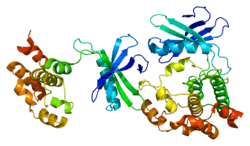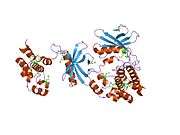WNK1
| View/Edit Human | View/Edit Mouse |
WNK lysine deficient protein kinase 1, also known as WNK1, is an enzyme that in humans is encoded by the WNK1 gene.[3] The human gene is located on short arm of chromosome 12 (12p13.3).
WNK1 is also known as Human Accelerated Region 5. WNK1 may have played a key role in differentiating Humans from Apes.
Structure
The WNK1 protein is composed of 2382 amino acids (molecular weight 230 kDa). The protein contains a small N-terminal domain followed by the kinase domain and a long C-terminal tail. The kinase domain has some similarity to the MEKK protein kinase family.
Function
The WNK1 gene encodes a cytoplasmic serine-threonine kinase expressed in the distal nephron.[3]
The protein appears to be part of the ERK5 MAP kinase pathway upstream of MEKK2 / MEKK3 and to function as a tetramer. It selectively binds to and phosphorylates synaptotagmin 2 (SYT2) within its calcium-binding C2 domains. It activates the serum- and glucocorticoid-inducible protein kinase SGK1, leading to activation of the epithelial sodium channel. It along with WNK4 stimulates clathrin-dependent endocytosis of renal outer medullar potassium 1 (ROMK1). It (and WNK4) interactes with intersectin (ITSN1, ITSN2).
Clinical significance
WNK1 has mutations associated with Gordon hyperkalemia-hypertension syndrome (pseudohypoaldosteronism Type II, featuring hypertension) and congenital sensory neuropathy (HSAN Type II, featuring loss of perception to pain, touch, and heat due to a loss of peripheral sensory nerves).[4] See also: HSN2 gene.
Comparative genomics
The gene belongs to a group of four related protein kinases (WNK1, WNK2, WNK3, WNK4).
Homologs of this protein have been found in Arabidopsis thaliana, C. elegans, Chlamydomonas reinhardtii and Vitis vinifera as well as in vertebrates including Danio rerio and Taeniopygia guttata.
References
- ↑ "Human PubMed Reference:".
- ↑ "Mouse PubMed Reference:".
- 1 2 "Entrez Gene: WNK1 WNK lysine deficient protein kinase 1".
- ↑ Shekarabi M, Girard N, Rivière JB, et al. (July 2008). "Mutations in the nervous system--specific HSN2 exon of WNK1 cause hereditary sensory neuropathy type II". J Clin Invest. 118 (7): 2496–2505. doi:10.1172/JCI34088. PMC 2398735
 . PMID 18521183.
. PMID 18521183.
Further reading
- Hart GW, Haltiwanger RS, Holt GD, Kelly WG (1989). "Nucleoplasmic and cytoplasmic glycoproteins.". Ciba Found. Symp. 145: 102–12, discussion 112–8. PMID 2507249.
- Nakajima D, Okazaki N, Yamakawa H, et al. (2003). "Construction of expression-ready cDNA clones for KIAA genes: manual curation of 330 KIAA cDNA clones.". DNA Res. 9 (3): 99–106. doi:10.1093/dnares/9.3.99. PMID 12168954.
- Xu BE, Lee BH, Min X, et al. (2005). "WNK1: analysis of protein kinase structure, downstream targets, and potential roles in hypertension.". Cell Res. 15 (1): 6–10. doi:10.1038/sj.cr.7290256. PMID 15686619.
- Subramanya AR, Yang CL, McCormick JA, Ellison DH (2006). "WNK kinases regulate sodium chloride and potassium transport by the aldosterone-sensitive distal nephron.". Kidney Int. 70 (4): 630–4. doi:10.1038/sj.ki.5001634. PMID 16820787.
- Huang CL, Kuo E (2007). "Mechanisms of disease: WNK-ing at the mechanism of salt-sensitive hypertension.". Nature Clinical Practice Nephrology. 3 (11): 623–30. doi:10.1038/ncpneph0638. PMID 17957199.
- Bonaldo MF, Lennon G, Soares MB (1997). "Normalization and subtraction: two approaches to facilitate gene discovery.". Genome Res. 6 (9): 791–806. doi:10.1101/gr.6.9.791. PMID 8889548.
- Nagase T, Ishikawa K, Nakajima D, et al. (1997). "Prediction of the coding sequences of unidentified human genes. VII. The complete sequences of 100 new cDNA clones from brain which can code for large proteins in vitro.". DNA Res. 4 (2): 141–50. doi:10.1093/dnares/4.2.141. PMID 9205841.
- Moore TM, Garg R, Johnson C, et al. (2000). "PSK, a novel STE20-like kinase derived from prostatic carcinoma that activates the c-Jun N-terminal kinase mitogen-activated protein kinase pathway and regulates actin cytoskeletal organization.". J. Biol. Chem. 275 (6): 4311–22. doi:10.1074/jbc.275.6.4311. PMID 10660600.
- Disse-Nicodème S, Achard JM, Desitter I, et al. (2000). "A new locus on chromosome 12p13.3 for pseudohypoaldosteronism type II, an autosomal dominant form of hypertension.". Am. J. Hum. Genet. 67 (2): 302–10. doi:10.1086/303020. PMC 1287179
 . PMID 10869238.
. PMID 10869238. - Wilson FH, Disse-Nicodème S, Choate KA, et al. (2001). "Human hypertension caused by mutations in WNK kinases.". Science. 293 (5532): 1107–12. doi:10.1126/science.1062844. PMID 11498583.
- Veríssimo F, Jordan P (2001). "WNK kinases, a novel protein kinase subfamily in multi-cellular organisms.". Oncogene. 20 (39): 5562–9. doi:10.1038/sj.onc.1204726. PMID 11571656.
- Xu BE, Min X, Stippec S, et al. (2003). "Regulation of WNK1 by an autoinhibitory domain and autophosphorylation.". J. Biol. Chem. 277 (50): 48456–62. doi:10.1074/jbc.M207917200. PMID 12374799.
- Strausberg RL, Feingold EA, Grouse LH, et al. (2003). "Generation and initial analysis of more than 15,000 full-length human and mouse cDNA sequences.". Proc. Natl. Acad. Sci. U.S.A. 99 (26): 16899–903. doi:10.1073/pnas.242603899. PMC 139241
 . PMID 12477932.
. PMID 12477932. - Vitari AC, Deak M, Collins BJ, et al. (2004). "WNK1, the kinase mutated in an inherited high-blood-pressure syndrome, is a novel PKB (protein kinase B)/Akt substrate.". Biochem. J. 378 (Pt 1): 257–68. doi:10.1042/BJ20031692. PMC 1223938
 . PMID 14611643.
. PMID 14611643. - Delaloy C, Lu J, Houot AM, et al. (2004). "Multiple promoters in the WNK1 gene: one controls expression of a kidney-specific kinase-defective isoform.". Mol. Cell. Biol. 23 (24): 9208–21. doi:10.1128/MCB.23.24.9208-9221.2003. PMC 309643
 . PMID 14645531.
. PMID 14645531. - Xu BE, Stippec S, Lenertz L, et al. (2004). "WNK1 activates ERK5 by an MEKK2/3-dependent mechanism.". J. Biol. Chem. 279 (9): 7826–31. doi:10.1074/jbc.M313465200. PMID 14681216.
- Fu GK, Wang JT, Yang J, et al. (2005). "Circular rapid amplification of cDNA ends for high-throughput extension cloning of partial genes.". Genomics. 84 (1): 205–10. doi:10.1016/j.ygeno.2004.01.011. PMID 15203218.
- Jin J, Smith FD, Stark C, et al. (2004). "Proteomic, functional, and domain-based analysis of in vivo 14-3-3 binding proteins involved in cytoskeletal regulation and cellular organization.". Curr. Biol. 14 (16): 1436–50. doi:10.1016/j.cub.2004.07.051. PMID 15324660.
External links
- GeneReviews/NCBI/NIH/UW entry on Pseudohypoaldosteronism Type II
- GeneReviews/NIH/NCBI/UW entry on Hereditary Sensory and Autonomic Neuropathy Type II




